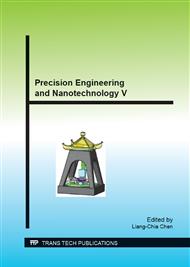p.678
p.683
p.689
p.695
p.700
p.706
p.712
p.717
p.722
Numerical Simulation Research of an Ultra-Micro Dispensing
Abstract:
Along with the miniaturization of products and the precision of micro-assembly, the ultra-micro dispensing is an important guarantee to realize precision assembly. In this paper, we analyze the dynamic process of an ultra-micro (fL class) dispensing based on the micro-droplet surface tension. According to the analysis, the micro-fluid dynamics model is built in the CFD (Computational Fluid Dynamics) software Fluent14.0 program, and the working process is dynamically simulated based on the model. Furthermore, the experiment platform is established and actual dispensing process similar to the simulation is successfully acquired under the same conditions. Finally, the diameters of actual dispensing dots are compared with simulation values respectively under the same three sets of different dispensing parameters, and results show that actual values keep high consistency with the simulations, which verifies the correctness and feasibility of the proposed micro-fluid dynamics model.
Info:
Periodical:
Pages:
700-705
Citation:
Online since:
August 2014
Authors:
Price:
Сopyright:
© 2015 Trans Tech Publications Ltd. All Rights Reserved
Share:
Citation:


